

New Hampshire Times - January 12, 1977 - Page 16
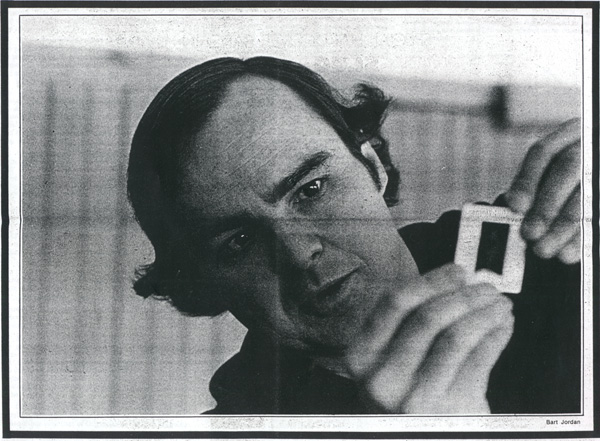
Ed. Note: When Bart Jordan first entered the New Hampshire Times office with his story of ancient civilizations, their symbols and meanings, we weren't at all sure that it was meant for a mass audience, or that a newsmagazine could handle it properly--we're still not sure. But Jordan was a New Hampshirite with a fascinating tale, and a problem. It seems that Russian decipherers are on the verge of discovering the derivation of the meander--one of mankind's oldest symbols--and Jordan felt a pressure to publish his work quickly. We agreed to help, and what you are about to read concerning the meander symbol has never been published before.
Our difficulty with this article is perhaps the same difficulty we would have felt had Albert Einstein entered these offices and announced, "Have I got a scoop for you--E=mc2." The subject matter is complex--perhaps too complex to be reduced to 2,000 words.
But we urge you to read this report of Bart Jordan's work--slowly. You'll discover the origin and meaning of the swastika symbol, why a yurt is shaped the way it is, and that people living 30,000 years ago were of a sophistication and intelligence far beyond that normally attributed to them.
Bart Jordan's fascination for deciphering the mind of upper paleolithic culture fires the instinct we all share in knowing and ordering the perceived world. The risk of surrender to such fascination, however, is high indeed--to be consumed by the suction of a jealous idea.
Yet success in deciphering the oldest symbols of humanity and the concepts of Cro-magnon peoples living 30,000 years ago can lead to a world-wide radical rethinking of what intellectual capabilities the ancients possessed. It can lead to the re-thinking of how we moderns tie not merely to our ultimate ancestors but to ourselves as cultural legacies of the early millennia and to the Mother Earth that bears and sustains us. In short, few powers wallop an impact as does the power of a persuasive idea, jealous or not.
For seven years Bart Jordan of Durham delved into the raw imagination and logic of early man. He made 70,000 draftings of symbols to discover the archeology of paleolithic thought. He laid aside his concertizing of classical guitar and lute because the intellectual, emotional, and creative drive of his work demanded it. When he says, "It's easier to dig a gold pot, than an idea," he says it in one of the 20 languages he needed to know to trace derivations of the symbols he discovered.
He calls his work a search, not research. "You have to think of yourself as someone who walks into a room and is confronted with signs or symbols, but walk in with virtually a blank slate," he said, adding the wise man's motto of I know enough to know I know not. "A decipherer has to try to put his mind into the mind of the family of man. He has to be prepared to reside with the family of man and to say there is continuity here, there is historical consciousness. He is searching for the symbol or representation of thought and cognition."
In other words, he is searching for the lowest common denominator of intellect, that which forms the rudiments of a culture, the fundamentals that must come first in order to accomplish the rest. It is not explaining the Rosetta Stone that already had two of its three languages known. Rather, it is deciphering concepts that allow such an artifact as a Rosetta Stone to be engraved in the first place.
Jordan will talk for hours on the thought processes of the ancients as if those people were neighbors down the street. In reality, he finds they are neighbors merely in time. His files are full of exacting drawings depicting these processes. Some are structured from extant examples from paleolithic times, others are logical deductions of his own. Some reflect the colors of the rainbow in symbolic context; all reflect a precision of line and number.
"We look at the ancients sort of disparagingly and think them unable to show us anything we don't know," he said. "Their synbols show us that they brought everything down to its most universally receivable form, to the root form. The ancient people had to use their wits to survive in a way we do not. Their symbols therefore reflect the basic kinds of thinking irrespective of being a child or adult. All participated in this symphony of thought. This is the beauty of thinking."
The numerical beauty of music was the springboard that led to Jordan's cultural deciphering. When he was 17 years old, he met Andres Segovia, the noted classical guitarist, who took him to the monastery El Escorial in Spain where he studied sacred and secular music and various stringed instruments. One day he played a 16th century piece for the Spanish conductor Ataulfo Argenta. The conductor spotted a hidden melodic line and urged Jordan to study it and other compositions of the same period.
"It awakened in me that I had found a path through the performance practice of the 16th century," he said. He presented the findings to the American Musicological Society in 1964. And his mind became set to restructuring music and other systems of thought.
Because of growths on his fingers, Jordan had to stop performing for 10 years. Meanwhile, he continued researching music systems, which led to early Greek music. (He deciphered for the first time a Greek music system that allowed him to premiere the "Epitaph of Seikilos" and "Delphic Hymn to Apollo" at the Library and Museum of Lincoln Center in New York City in 1969. The music fragments were 2,400 years old.)
He saw overlaps of Greek and Renaissance systems. "I thought to myself, I wonder if the tunings A-D-G-c-f and G-C-F-a-d-g represent some kind of harmonic wheel," he said. "It is at that point that I took a statement of Plutarch about the ancient Chaldeans saying that spring was a fourth from the autumn and a fifth from the winter. The Chinese said the same thing except that the spring to the summer was a major second as opposed to an octave."
He set up a harmony wheel of 20 semitones based on the human hand. (The word "score" is a central musical word.) He then added five more semitones in order to complete the range for the tetrachord system.
"I said to myself, what does solstice and equinox and the seasons have to do with music," he said, "and that's when I began to realize there must be a system older than this."
The Greeks, especially the Pythagorians, referred constantly to number as the basis of the intellectual ordering of what otherwise is chaos. It is number that Jordan zeroed in on.
He knew that the Greeks had two music systems-- the greater perfect tetrachord and the lesser perfect trichord systems. "So I said, if the five-semitone units of the lesser perfect system represented the year of 365 days and the six-semitone units of the greater perfect system represented the leap year of 366 days, there must be a base year at something--360. And that turned out to be the case."
Gradually, Jordan's mind turned from musicology to cultural deciphering. The adventure of his search is no less exciting than that of Odysseus or Cook or Magellan. What follows here is his discovery, his uncovering of paleolithic concepts of the world. They are partly deductions of his own concerning extant symbols. The meander symbol, for example, is found everywhere throughout the world and is one of the oldest signs of humankind. It has never before been successfully explained. Jordan is convinced that he has deciphered its construction and meaning.
To trace his explanation, however, requires following part of the path that he himself followed. It is painstaking and exacting, but taking the time to understand each step is worth the final clarity and wonder that results.
First of all, Jordan deciphers the swastika (like the meander, one of the oldest symbols of all of the year). It is designed in perfect harmony with itself.
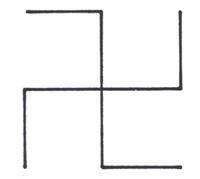
Directional signs formed the parts of the swastika. Walking north led to cold, death, and winter; east led to sunrise, origination, rebirth, and spring; south to warmth, life, and summer; west to sunset, time of fading, time of waning, and autumn. These elemental signs joined to make the swastika
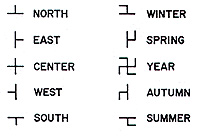
"It was nothing more remarkable than that," Jordan said, "and it went all over the world. It certainly didn't originate with the Aryans and was used in reverse by the Nazis. It originated with the paleolithics."
The ancients looked at the seasons with admiration and awe. Their use of the swastika (a corruption of a Sanskrit word) was the symbol of harmony with the universe.
No one else has broken down a swastika into seasonal parts, Jordan said, although the two directional symbols for north and south refer to up and down in ancient Chinese.
As for the swastika itself, one of his children found among Viking antiquities an elaboration of the symbol on horse trappings. The representation was constructed of 36 lines and therefore referred to the 360-day year: "This is further supported by the fact that there were two correctly drawn swastikas on either side," he said.
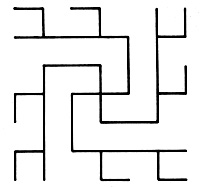
In many cultures the horse was regarded as the year bearer. "In fact, the Scythians in south Russia in the sixth century B.C. buried 360 horses in rounds of 18," Jordan said. "They were set in a swastika-manner."
Jordan asks what was the original method of writing. He said it was placing numbers around a circle in relation to the eight peripheral directions for immediate and universal recognition. The number nine was extremely significant to the ancients. Any two numbers opposite each other around the wheel added to nine, the four nines (tetractys) adding to 36:
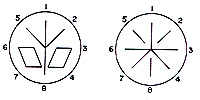
Jordan documents the number-direction unit as the origin of several star symbols (above) representing the planet Venus. A mask shaped like figures found in both paleolithic and neolithic times is related to the above left-hand symbol.
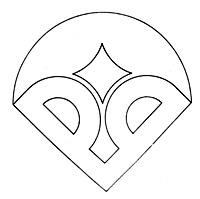
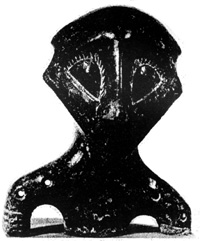
The numbers 1 3 4 7 6 assigned to the five points around the right-hand symbol (above), if multiplied sequentially, result in 504. The numbers assigned to the three smaller points result in 80. Adding these two products together equals 584.
"Just as the earth goes around the sun in 365.25 days," Jordan said "the ancients realized that the apparent or synodical revolution of Venus was 584 days. And to have done that in the paleolithic period is highly significant."
Modern astronomy establishes the average apparent revolution of Venus, third brightest object in the sky and therefore important to the paleolithics, at 583.921 days.
The following series of deductions result in large part from the'ancient view of the year being divided into 13 segments that correspond to the waxing and waning of the female cycle roughly corresponding to the moon. The sequence of Jordan's steps leads to his explanation of various ancient symbols found in caves and on statuettes.
Basically, his process begins with numbers referring to concepts of time. The female averages 13 menstrual cycles a year. The ancient female figure is drawn with 13 line-segments.
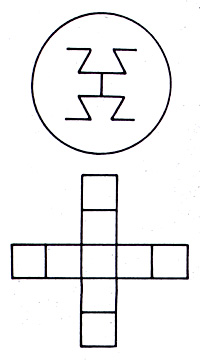
The ancients, Jordan said, constructed a menstrual month calendar symbol with 28 line-segments (above right) representing the 28-night average menstrual cycle. These two figures, 13 and 28, multiplied together result in the 364 nights of the lunar-menstrual year.
Similarly, the sun calendar symbol is drawn with 24 line-segments. (Both the lunar and solar grids have the magic nine squares.) The male figure is drawn with 15 lines. These two numbers of 24 and 15 multiply to 360, the base year.
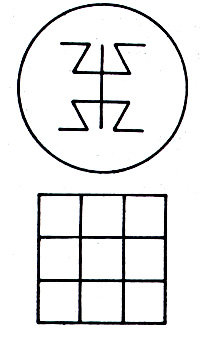
When these two grids are superimposed, they form the lunar-solar grid. The lunar-solar symbol represents the House of Light and is constructed of 36 lines referring to the 360-day base year. The numbers that it contains, 1 through 8, add up to 36, again referring to the 360 base year. Jordan assigned the colors of red, orange, yellow, green, and blue of the rainbow arc (representing the intercalary days) to the inner squares of the lunar- solar calendar grid.
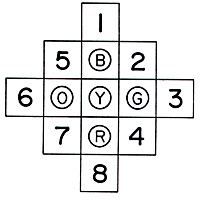
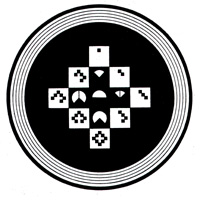
Curiously, the geat Maya-Toltec temple in Yucatan with its four stairways emanating from the central tier relates to the 13-halls diagram above. The 91 steps on each of the four sides add to 364, the number of nights in the lunar-menstrual year.
"The counts in the ancient world started from the left hand," Jordan said. "All of them. The left hand in Latin is called the 'sinister' one. It started the menstrual count with the 14 phalanges of the left hand and finished with the 14 phalanges of the right hand." Each finger has three phalanges, the thumb two. "There are places in the world today where the women still count with the phalanges--14 and 14 totaling 28."
Jordan ran straight lines through the center of the squares beginning with number one and going through seven, totaling 28, the number of nights in the menstrual cycle. The 28 also refers to 280, essentially the human birth cycle.
The line through the color red symbolizes menstruation. "It gives us for all intents and purposes a yurt," he said. "We have these on the paleolithic walls. They have already been assigned by art historians as female signs. These concepts go. back 30,000 years without any doubt in my mind."
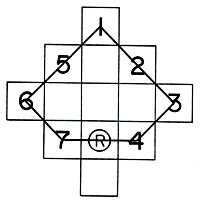
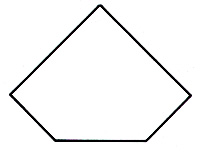
Other signs give his outline in variation as places of emergence, referred to as the Seven Caves in Central American Indian culture. "So again," he said, "it is a symbol for the menstrual cycle."
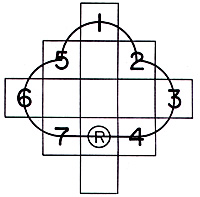

The pubic triang1e, a menstrual symbol, found in paleolithic times is again explained by Jordan's basic design. "Incidentally, later on the identical Hittite pictograph stands for woman,' he said.
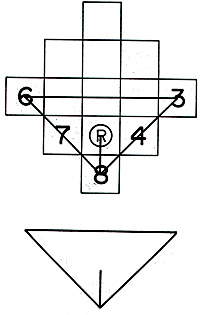
Some of Jordan's findings are related to the paleolithic relief called the "Venus" of Laussel. He prefaces his explanation by saying that the Sioux Indian shaman Black Elk "makes a point of saying that the bison stands for 28 because of the 28 ribs. The 'Venus' symbol of Laussel is clearly depicted with the bison horn and is related to the crescent moon," Jordan said, explaining the photograph in "The Roots of Civilization" by Alexander Marshack. "The horn she's holding has 13 lines etched in. The bison horn is not alone in standing for 28 nights. Her left hand is on her stomach and her face is pointed toward the right hand which completes the count. Certainly she is a lunar-menstrual figure celebrating fertility, pregnancy, and birth with the concept of 13 times 28."
The relief is thought to be from the upper paleolithic period, approximately 15,000 years ago.
"But the most persuasive aspect of all is among the oldest symbols that we have in the world, older than the extant swastikas," he said, referring to the meander signs on the Mezin bracelet found in the Ukraine and dated 22,000 years ago.
The meander is found in cultures throughout the world. In one representation, it is the Greek key. As an interchangeable symbol with the swastika for the year, it may be found. around the edge of ceramic ware to signify the wish of many good years ahead.
It is usually seen this way:

How the meander was designed and with what concepts has never been deciphered successfully. Jordan explains it this way:
He believes it is a sun-centered concept of the universe. By drawing lines through all the year-numbers and all the intercalary day-colors in sequence in the lunar-solar calendar, the meander covers all 13 boxes representing the year.
From number one, the line moves clockwise until it touches yellow, the sun center. Then it moves counter-clockwise, as is the real motion of the earth in relation to the sun. "It's not just a neat set of numbers and colors," Jordan said, "it points to a basic concept of solar mechanics, presumably understood by these people in some degree."
The meandering line continues to move until the familiar, world-wide, previously undeciphered symbol is explained with brilliant clarity.
"That is the explanation of the world's oldest extant symbol relating to the year," Bart Jordan said. "This clearly is paleolithic. This is the one symbol that proves the existence of the 13 halls replete with the year-numbers and the intercalary day-colors because there is no other way you can get both the year-numbers and the day-colors to follow their natural order of 1, 2, 3, 4, red, orange, yellow, green, blue, 5. 6, 7, 8. That's not an accident. That is proof."
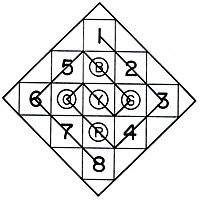
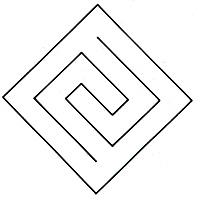
"Some people say its a shame we've lost everything," Jordan said. "Well, we really haven't. It's just a matter of putting those pieces together. That's what the deciferer has to do."
by Steve Sherman
Next week: The White Goddess and the maze of Knossos.